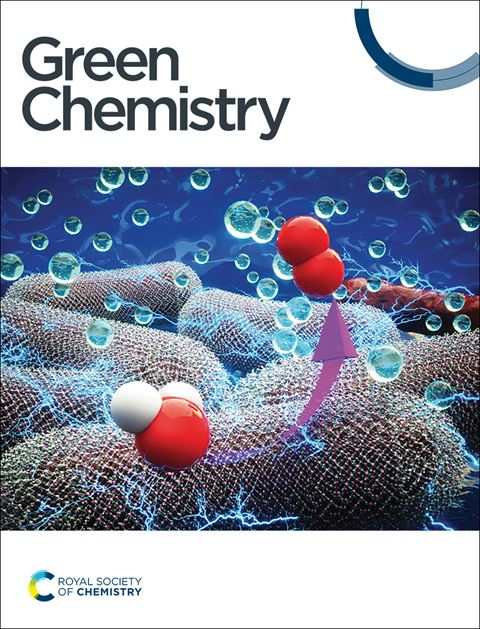用碳酸二甲酯从葡萄渣中高效、选择性地提取齐墩果酸
IF 9.3
1区 化学
Q1 CHEMISTRY, MULTIDISCIPLINARY
引用次数: 0
摘要
葡萄渣是酿酒厂的主要固体残留物,全世界每年生产数吨。由于葡萄渣是一种高附加值化合物的宝贵来源,因此已经实施了许多战略来提高其价值。提取具有广泛用途的生物活性分子无疑是研究最多的课题。在这方面,最近在葡萄渣中发现了一种具有相关生物活性的三萜类化合物齐墩果酸,其含量非常高(每克新鲜葡萄渣中含有 0.45 毫克)。在此,我们报告了使用碳酸二甲酯(DMC)从葡萄渣中选择性提取齐墩果酸的方法,碳酸二甲酯是一种值得推荐的绿色溶剂,是化石溶剂的最佳替代品。研究人员考虑了化学物理特性、希尔德布兰德溶解度和卡姆莱特-阿伯德-塔夫参数,以选择一种更环保的溶剂替代化石基溶剂,并进行了理论计算,以确定 DMC 与齐墩果酸之间的相互作用。通过核磁共振和液相色谱-质谱法对获得的葡萄渣提取物进行了表征。由于 DMC 极性弱,形成 H 键的能力差,因此可以从葡萄渣中回收齐墩果酸,摩尔选择性为 61%,从而促进了生物质残留物价值化的绿色可持续替代技术的采用。此外,DMC 在连续三次萃取中被回收和重复使用,在齐墩果酸萃取率方面没有发现明显的损失。本文章由计算机程序翻译,如有差异,请以英文原文为准。


Efficient and selective extraction of oleanolic acid from grape pomace with dimethyl carbonate†
Grape pomace is a major winery solid residue and several tons are annually produced worldwide. Since it is a valuable source of high value-added compounds, many strategies have been implemented for its valorization. The extraction of bioactive molecules with a broad range of applications is certainly the most investigated topics. In this context, oleanolic acid, a triterpenoid with a relevant biological activity, has been recently detected in grape pomace in remarkable quantities (0.45 mg per gram of fresh pomace). Herein, we report on a selective extraction of oleanolic acid from grape pomace by using dimethyl carbonate (DMC), a recommended green solvent as a better alternative to fossil-based solvents. Chemical–physical properties, Hildebrand's solubility and Kamlet–Abboud–Taft parameters have been considered to select a greener alternative to fossil-based solvents and theoretical calculations have been performed to determine the interaction between DMC and the oleanolic acid. The obtained grape pomace extracts were characterized by means of NMR and LC-MS. DMC allows the recovery of oleanolic acid from grape pomace, due to its weak polarity and poor ability to form H-bonds, with a molar selectivity of 61%, thus promoting the adoption of alternative green and sustainable technologies for biomass residue valorization. Also, DMC was recycled and reused in three consecutive extractions and no significant losses in terms of oleanolic acid extraction yield were detected.
求助全文
通过发布文献求助,成功后即可免费获取论文全文。
去求助
来源期刊

Green Chemistry
化学-化学综合
CiteScore
16.10
自引率
7.10%
发文量
677
审稿时长
1.4 months
期刊介绍:
Green Chemistry is a journal that provides a unique forum for the publication of innovative research on the development of alternative green and sustainable technologies. The scope of Green Chemistry is based on the definition proposed by Anastas and Warner (Green Chemistry: Theory and Practice, P T Anastas and J C Warner, Oxford University Press, Oxford, 1998), which defines green chemistry as the utilisation of a set of principles that reduces or eliminates the use or generation of hazardous substances in the design, manufacture and application of chemical products. Green Chemistry aims to reduce the environmental impact of the chemical enterprise by developing a technology base that is inherently non-toxic to living things and the environment. The journal welcomes submissions on all aspects of research relating to this endeavor and publishes original and significant cutting-edge research that is likely to be of wide general appeal. For a work to be published, it must present a significant advance in green chemistry, including a comparison with existing methods and a demonstration of advantages over those methods.
 求助内容:
求助内容: 应助结果提醒方式:
应助结果提醒方式:


